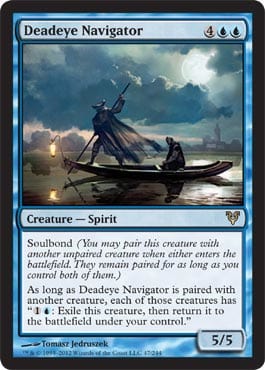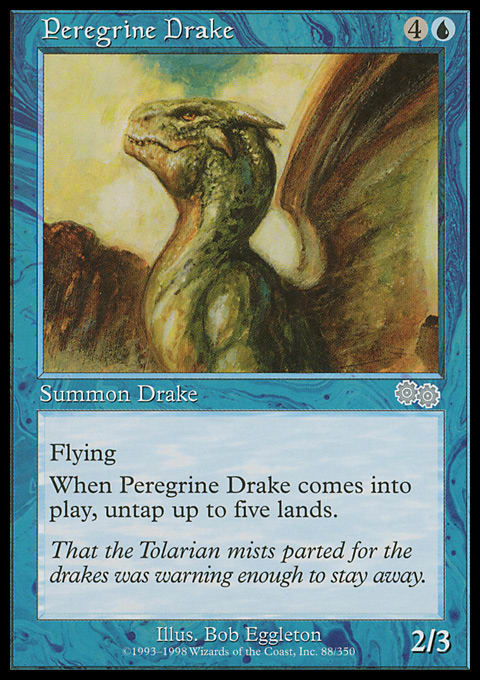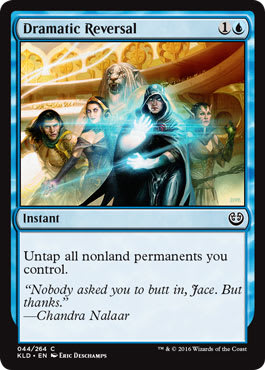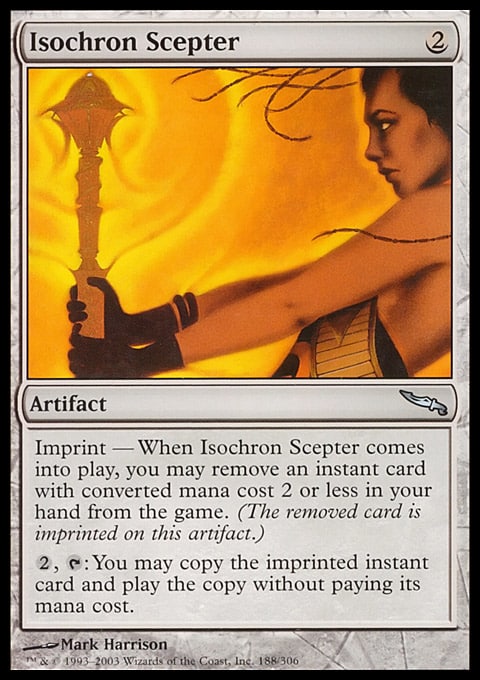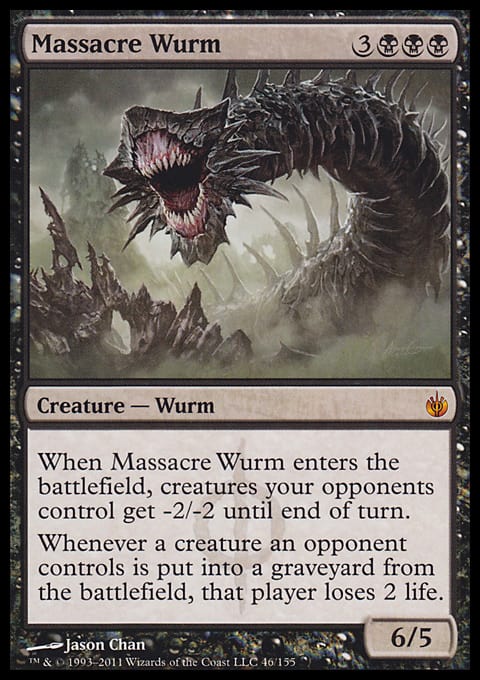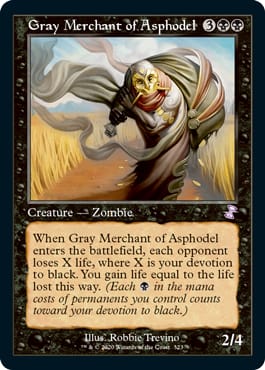Earlier this month, fellow CoolStuffInc.com writer Mark Wischkaemper shared a first look at an exciting new Dimir (![]()
![]() ) commander, Satoru Umezawa. If you haven't read his take on this spicy new legendary creature, you can (and should) read it here.
) commander, Satoru Umezawa. If you haven't read his take on this spicy new legendary creature, you can (and should) read it here.
Mark did a great job at digging into ways to abuse Satoru Umezawa, with a focus on cheating big threats onto the battlefield. His build was something of a budget affair, running Titans, Primordials and a Praetor, but he held back a little. He didn't run Blightsteel Colossus or any of the many Eldrazi that could be real headaches for your tablemates. I expect he doesn't like to kick a tablemate to the curb really early when EDH games can go for an hour or more, but those omissions might also have been for budgetary reasons.
As soon as I saw Satoru Umezawa, my mind didn't go to how often I could cheat in a Blightsteel Colossus after blocks. I was fascinated by his second ability. Let's take a another look at this crafty Ninja.
Satoru Umezawa lets you look at the top three cards of your library, and put one into your hand and the rest on the bottom of your library whenever you activate a ninjutsu ability. That "whenever" rings a bit hollow when you realize this ability triggers only once each turn. Any crazy combo using that first ability to draw your entire deck would have to allow you to flicker Satoru before each new activation of ninjutsu. He also gives each creature card in your hand ninjutsu, at a cost of 2UB. If a creature in your hand already has ninjutsu, it will get an additional instance of that ability and you'll be able to pick which one you want to use.
I've got a long history of having incorrect "first takes" when I look at exciting new Magic cards, and I went for a short time not realizing that his first ability only triggers once each turn. I generally catch those mistakes before I put them into a column, and in this case that restriction makes the card much more balanced. Satoru Umezawa is still a bonkers card, though, and not just because of his Sneak Attack trick. Let me explain why.
Activating ninjutsu allows you to return target unblocked creature you control to your hand and to replace it with the creature with ninjutsu. The new creature that just entered will still be tapped and attacking. This means you can use ninjutsu multiple times and you can put the ability on the stack, hold priority, do it again, hold priority, do it again, etc... Gavin Verhey goes into detail about some interesting loopholes around ninjutsu in a recent youtube video you can watch here and if you're interested in playing with ninjas in Magic, it is well worth a look.
Abusing Ninjutsu
My excitement about Satoru Umezawa had little to do with cheating bombs into play - no offense to those of you who want to pop a Titan onto the field for four mana or knock someone out on turn four with a Blightsteel Colossus. That's one way to have fun, but I hate kicking someone to the curb early so my mind naturally went to ways I could combo off and kill the table all at once. One might argue that my approach to EDH is no less toxic, but if someone does have an answer, at least nobody will be sitting around bored for an hour or more if the game goes long.
My plan has to do with making infinite mana and then using it to ninjutsu a creature in and out of play as many times as I want.
But wait - it says you can only do that once per turn, right?
Yes... and no.
My first read of Satoru missed that "once per turn" caveat, but when you look closely, you'll realize that restriction only applies to his "look at three cards..." ability. Satoru still gives each creature card in your hand ninjutsu, so if you've got the mana you can ninjutsu the creature you just put in your hand back onto the field in place of the creature you just cheated into play.
Wizards of the Coast has an arguably bad habit of making toxic overpowered legendary creatures that are both extremely oppressive and that have the ability to turn infinite mana into a win. Tergrid, God of Fright // Tergrid's Lantern is a great example. She's very strong on her own, but for some reason the game designers over at WotC decided to give her a flip side that would let infinite mana win the game with infinite Lantern untaps and activations.
Satoru Umezawa isn't as badly designed as Tergrid and we'll have to do some setup and jump through some hoops to really abuse him. I like that, as it makes this build more of a challenge and could lead to the deck playing out in different ways. I'll have to be able to make infinite mana during combat because your mana pool empties between steps and phases. I'll have to have ways to filter mana so that if I'm making colorless mana I can still use it to pay the color requirements of my ninjutsu activations. I'll also have to have creatures that do something to advance my board or let me win the game when I "go off".
Destination: Combotown
Sometimes you start at the beginning, but today's story isn't a mystery. We're not taking a left turn at Albuquerque and ending up in Combotown - we're punching our destination into the GPS, packing our bags and hitting the road with full knowledge of where we are headed.
The all-too-familiar Deadeye Navigator combo is a good place to start. We soulbond Deadeye to Peregrine Drake, Great Whale, or Palinchron and use the souldbonded creature's newly granted flicker ability to make infinite mana. Pay 2 to flicker, untap 5 or 7 lands when it enters the battlefield. Easy peasy.
It's worth noting that if you have a way to get your islands or swamps to tap for more mana, you might be able to combo off without Deadeye Navigator. All you have to do is be able to make 9 mana with the 5 (or 7) lands you'll be untapping. You have to pay 8 (2 x ![]()
![]()
![]() ) mana in total to ninjutsu a your untapper back to your hand and then ninjutsu it back into play, as that would be two activations. It might be a challenge with Peregrine Drake, but with either of the creatures that untap seven lands, a single High Tide, Bubbling Muck, Crypt Ghast or Nirkana Revenant could mean you're off to the races.
) mana in total to ninjutsu a your untapper back to your hand and then ninjutsu it back into play, as that would be two activations. It might be a challenge with Peregrine Drake, but with either of the creatures that untap seven lands, a single High Tide, Bubbling Muck, Crypt Ghast or Nirkana Revenant could mean you're off to the races.
Decks not in Green will often run extra artifact ramp, and in Dimir colors all those extra rocks set up a deck to be able to play the "Dramatic Scepter" combo. If you have enough mana rocks to generate three mana, you imprint Dramatic Scepter onto your Isochron Scepter and when you use it to cast that particular Blue instant, it untaps your rocks and your Scepter so you can do it again and again, netting mana each time.
Rings of Brighthearth can work with Basalt Monolith or Grim Monolith to make infinite mana. You use Rings not to copy the mana ability, but to copy the untap ability, allowing you to untap, tap in response, and then untap again. Infinite mana is great, but doesn't help you pay a ![]()
![]()
![]() ninjutsu activation unless you have a way to filter that mana. Fortunately, Stonework Packbeast, Signpost Scarecrow, and Prismite will all be happy to jump in and lend a hand. Chromatic Orrery will also fit in nicely, letting me use my mana as if it were mana of any color.
ninjutsu activation unless you have a way to filter that mana. Fortunately, Stonework Packbeast, Signpost Scarecrow, and Prismite will all be happy to jump in and lend a hand. Chromatic Orrery will also fit in nicely, letting me use my mana as if it were mana of any color.
That last combo might be the first that I would consider taking out if it felt like the deck wasn't working well enough. Grim Monolith is a very expensive card and this only makes colorless mana - requiring me to jump through extra hoops to actually use it for ninjutsu activations.
All That Mana
If all goes well, I'll have positioned myself to be able to create infinite mana in both Blue and Black at instant speed in the middle of combat once I've got an unblocked creature on my hands. I've got a few unblockable creatures and creatures with flying, which will often be a viable way to get to that ninjutsu activation.
A bunch of those flyers can draw me a card when they enter the battlefield. That means when I combo off and start going crazy with ninjutsu activations, I can draw my deck. That means I can have Laboratory Maniac or Thassa's Oracle available to win via either of their win-the-game triggers, with counterspell backup to make sure I seal the deal.
If I'm not hitting creatures that let me draw to win, I'm going to hope I have hit something else useful.
Solemn Simulacrum might not seem like a big deal, but if I can dribble him like a basketball and put all my lands onto the battlefield, I'll be well positioned to push for a win even if my opponents manage to blow up my infinite mana combo. A Massacre Wurm will let me wipe my opponents' boards on my turn quite nicely, even clearing away indestructible threats. Gray Merchant of Asphodel simply wins the game if I can bounce him as many times as I like.
To be clear, my "dribbling" and "bouncing" refer to using ninjutsu to bounce an unblocked creature to my hand and playing one of these creatures, then swapping them again and again and again as many times as I like. Those ninjutsu'd in creatures are still attacking and they are still unblocked, so they are legal targets for additional ninjutsu activations.
Satoru Ninjutsu Combo
This list feels very much like another work in progress, but I think the concept is solid and that it should be able to work. You won't hit your combo every game, and I can see the desire to load up on at least a few big bombs, but ultimately that is a question for how you like to play the game. Would you rather try to fly under the radar and then launch into a game winning turn with a zillion ninjutsu activations where you use something unassuming like a Parasitic Strix to kill the table - or would you rather cheat in a giant creature or two to hit some unlucky tablemate for a quarter or more of their life total in one combat? Both? Both is good. Both can be fun, but today's list is all about the combo.
Satoru Ninjutsu Combo | Commander | Stephen Johnson
- Commander (1)
- 1 Satoru Umezawa
- Creatures (30)
- 1 Baleful Strix
- 1 Cloudkin Seer
- 1 Crypt Ghast
- 1 Dusk Legion Zealot
- 1 Fblthp, the Lost
- 1 Gifted Aetherborn
- 1 Gray Merchant of Asphodel
- 1 Great Whale
- 1 Invisible Stalker
- 1 Laboratory Maniac
- 1 Malakir Familiar
- 1 Massacre Girl
- 1 Massacre Wurm
- 1 Mulldrifter
- 1 Nirkana Revenant
- 1 Palinchron
- 1 Parasitic Strix
- 1 Peregrine Drake
- 1 Phyrexian Delver
- 1 Phyrexian Rager
- 1 Prismite
- 1 Ravenous Chupacabra
- 1 Rune-Scarred Demon
- 1 Sidisi, Undead Vizier
- 1 Signpost Scarecrow
- 1 Slither Blade
- 1 Solemn Simulacrum
- 1 Stonework Packbeast
- 1 Thassa's Oracle
- 1 Vampire Nighthawk
- Instants (12)
- 1 Arcane Denial
- 1 Counterspell
- 1 Dramatic Reversal
- 1 Fierce Guardianship
- 1 Force of Will
- 1 High Tide
- 1 Muddle the Mixture
- 1 Stoic Rebuttal
- 1 Swan Song
- 1 Vampiric Tutor
- 1 Bubbling Muck
- 1 Demonic Tutor
- Enchantments (3)
- 1 Mystic Remora
- 1 Phyrexian Arena
- 1 Rhystic Study
It's worth noting that I didn't look at many creatures from Kamigawa: Neon Dynasty, and I didn't go out of my way to include other Ninjas. I think you could make strong arguments for lots of changes to this list. I'm not running Swiftfoot Boots or Lightning Greaves, though both are staples for protecting your commander. I'm certainly running my fair share of staples. Good cards are good, and this is trying to be the kind of high power, high budget list I might be more likely to play online than in paper. I didn't include Underground Sea, but I did throw in Grim Monolith and Mana Crypt, both of which are pretty high end cards for casual EDH. Tuning this deck up would probably involve adding more interaction and maybe adding Demonic Consultation as another way to win with Thassa's Oracle.
Final Thoughts
I should note that today's list might be a little mana-heavy. I'm running an awful lot of mana rocks and while my lists usually run closer to 36 or 37 lands, I decided to position this draft achingly close to 40. It has become something of a drumbeat among the other writers at CoolStuffInc that every Commander deck should run 40 lands, and I've been joking with Mark Wischkaemper about it. I told him he'd hate this column because I probably wouldn't run 40 lands, and I had to follow through and stay under 40.
A lot of casual decks do suffer from not having enough lands, but the lower your mana curve is and the more draw and mana acceleration you have, the lower that land count can safely go. Variance is a real thing in Commander, and any deck can have games where you are "mana flooded", seeing way too many lands, or "mana screwed", not seeing enough lands. Most of us have a preference for which of these kinds of "bad games" we'd rather have, and I'd rather be screwed than flooded. Yes, you can quote me on that. I also usually have a lower mana curve than your average casual EDH deck, so my average 35-37 lands suits me just fine.
As long as you're having fun, that's what matters most. I do think it's sensible to start at 40 if you don't mind occasionally just drawing land when you'd rather be drawing non-lands. Don't expect me to be pushing the 40 lands mantra until I'm actually drunk that kool-aid and I am running 40 in my own decks. I'm not quite there yet, and I may never get there.
This column wasn't about land counts - it was about Satoru Umezawa. I'd bet that most Commander players can't resist the lure of abusing Satoru's first ability to drop a Colossus, a Praetor, a Titan or some other giant threat onto the field for a paltry four mana. Honestly - I don't blame you, and while today's list digs into the "other side" of Satoru Umezawa, I think it's possible that the most satisfying build will actually have a mix of the two.
If you've started brainstorming on how you might build Satoru Umezawa, I hope I've opened your eyes to some new options. Not everyone likes combo, but it's become a central part of the EDH experience for a lot of us and I'll always prefer to dribble a Gary and kill the table than cheat in a Blightsteel and possibly put a friend on the couch if the table stops me and the game goes long.
That's all I've got for today. Thanks for reading and I'll see you next week!


















